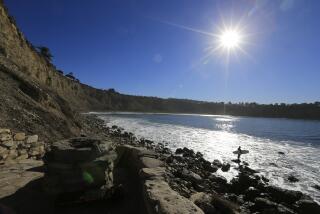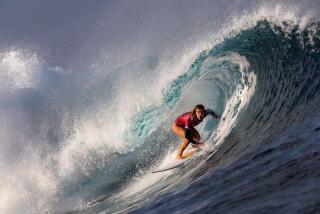DIFFERENT STROKES
- Share via
When Steven Moser paddles out at Bolsa Chica for one of his daily training sessions, surfers who haven’t seen him before turn to their buddies and mutter, “Oh great, here comes a guy on a damn kayak.” Then Moser, the No. 1-ranked wave skier in the country, rips down the face of a wave and explodes into the air off the lip and they shout, “The guy on the kayak is awesome, dude.”
“I still run into about three donkeys out of every 100 surfers who try to hassle me,” Moser says, “but as soon as they see me catch a wave and they see I have complete control, they realize, ‘Hey, he’s one of us.’
“We do sit on these things but we’re not kayakers. Don’t throw us in that category. We’re surfers.”
But surfers who have to use their arms to propel themselves onto the face of a swell usually aren’t overjoyed with the notion of competing for waves with someone holding a paddle. And the battle for space on the waves between sit-down surfers and the stand-up variety--already a full-blown conflict in Australia, South Africa and France--is heating up on Southland beaches.
Heck, they even argue about who came first.
According to the Guinness Book of World Records, the first known sighting of people surfing was recorded by Captain Cook in December of 1771, when he saw Polynesians riding waves in their canoes in Tahiti. Lt. James King first described seeing Hawaiians standing on surfboards in Hawaii’s Kealakekua Bay in March of 1779.
While the Hawaiian version of surfing has become a way of life as much as a sport for hundreds of thousands during the last half century, there are a few avid sit-down aficionados such as Moser who are beginning to turn on a whole new generation of wave riders.
Moser, 28, a global logistics consultant who lives in Palos Verdes, teaches clinics at Paddle Power in Newport Beach, one of the only places in Southern California where you can rent a wave ski. For $65, he gives a three-hour lesson--”or as long as they can last”--that begins in the bay and ends in the surf.
“It barely covers the petrol for the drive,” says Moser, who began wave skiing as a teen in Australia and is ranked No. 1 in the U.S. because he was the top American finisher (tied for 32nd) in last year’s world championships in Brazil. “But we need to do whatever we can to encourage young people in the country to get into the sport. It’s not like a Boogie Board or a shortboard that you can take on the bus or strap to your bike. It’s incredibly fun, but it requires a ride to the beach from mum or dad.”
Two Basic Designs
Versions of paddle-surfing have been around for nearly 40 years, the first models of wave skis initially developed as an adaptation of the Australian surf ski by a group of Huntington Beach lifeguards headed by Merv Larson, considered by most to be the father of the sport in this country.
Of course, you can ride a wave in a canoe if you want--if you don’t mind it swamping and sinking--but most modern paddle surfers fall into one of two categories. There is the California style, using either specially designed kayaks or sit-on-top boards with no fins that are steered primarily with the paddle, and the Australian or international style, using a smaller, lighter sit-on-top board that has a tri-fin set-up and is maneuvered mostly by switching body weight.
Both designs have flat or concave bottoms, a kicked-up nose that planes high in the water to allow quick turns, and rails somewhat similar to surfboards. The sit-on-top varieties have quick-release waist belts and ankle straps. Some also have thigh straps.
They range from about $500 for beginner models to nearly $1,500 for top-of-the-line designs of both the California- and Australian-style boards.
“It’s very much like the difference between short surfboards and longboards,” said Steve Boehne, who shapes wave skis for Infinity in Dana Point. “The Australian-style boards are seven to eight -feet long. I build primarily the California style, which are eight to 11 feet long.
“The longer waterline paddles faster and consequently catches waves easier than the shorter Aussie skis. A long ski glides into a wave early and does big, smooth turns. Because there’s no fin, you sort of slide into a turn before the rail bites into the wave. They’re also easier to master for a beginner and almost effortless for a good kayaker.”
But top competitors such as Moser use the Australian boards to pull off moves no kayaker who hasn’t mistakenly plunged over a waterfall ever dreamed of--360-degree spins in the air, where the board rotates like a helicopter blade, and aerial re-entries.
“The wave ski has come a long way,” Moser said. “The pro international boards are very light, 12 to 14 pounds, and built to allow for very critical maneuvers in the fastest section of the wave. It’s almost like snowboarding while sitting down.
“Most of the events that take place in the U.S. are sanctioned by the American Kayak Assn., which means we have to wear life jackets, helmets and have paddle leashes, which are very restricting. And the judging is different. In the international events, we use judges from the [Assn. of Surfing Professionals] tour.”
For most paddle surfers, the debate over which form of board is best is of little concern. Like wave riders the world over, they’re more concerned with swell size, wind direction and finding a wave to themselves.
At San Onofre State Beach, paddle surfers are confined to a designated area, but Moser, who has traveled much of the California coast in surf-safari training sessions, says he knows of no other beach that is segregated. Wave skiers are accustomed to being treated like lepers, though.
“I think a few guys in 50-pound plastic kayaks who got turned sideways in the whitewater and had no control as they cleared a swath all the way to the beach did most of the damage to our reputation,” Moser said. “That can be pretty intimidating to a surfer, or anyone else in the water, and very dangerous, so we’re not always welcome.”
Night Moves
Bill Luhrs, known to wave skiers and surf kayakers up and down the coast as Wild Bill, has the perfect antidote for crowded waves and bad vibes. He says the best days he has ever surfed were nights.
“There’s a special kind of magic after the sun goes down and it gets really dark,” he said. “Everything gets quiet and the water gets real glassy. When you’re screaming down the face of a large wave at night and you can’t see the bottom and the top is only a vague memory, sitting on a wave ski is like riding a magic carpet. There is no real experience that compares to it.
“And when it comes to night surfing, wave-ski surfing differs from traditional stand-up surfing in at least two important ways. One, with a wave ski you’re attached to your board with a seat belt so after a wipeout you don’t have to swim around in the dark looking for your board. And, two, you sit on top of your board, completely out of the water, so there is somewhat less fear of sharks . . . no bait dangling over the side.”
Luhrs, of Redondo Beach, has been riding wave skis for 15 years. He began on the finless-design board first created by Larson but has been competing on the International-class wave skis over the last few years. He won the expert sit-on-top division at the Santa Cruz Kayak surf festival in 1998 and has four third-place finishes over the last two years in competitions at Santa Cruz, Pismo Beach, Nags Head, N.C., and Cocoa Beach, Fla.
“If the contests were at night,” he says, “I’d have more firsts and fewer thirds.”
Wave skiers won’t have to hide in the dark much longer, if you believe Michael Francisco, founding member of the San Onofre Kayak Assn., who is trying to revive a club called the Western Waveski Assn. He points out that in some areas of Australia, stand-up surfers only outnumber their on-their-butt counterparts four to one.
Boehne is sure he knows why and can prove it.
“I’ve got a tandem ski, you’ve got to come down to San Onofre and try,” he said. “In five minutes we’ll be ripping it up. There’s nothing like it.”
(BEGIN TEXT OF INFOBOX / INFOGRAPHIC)
SITTIN’ IN THE SURF
Paddle surfing, already the rage in Australia, South Africa and Europe, is gaining popularity on Southland beaches. Sit-down surfers can perform many of the same maneuvers as their stand-up counterparts on a number of specially designed wave skis.
CALIFORNIA STYLE
A wave ski with a smooth bottom that slides and turns and can spin 360-degrees on the face of the wave. The design comes in moth sit-on-top models and enclosed, kayak-like shapes. They are more stable, easier to paddle but less maneuverable than the Australian style.
AUSTRALIAN STYLE
A shorter, lighter design with a tri-fin setup on the bottom that allows surfers to execute sharp turns, aerials and re-entry moves similar to professional surfers. They are more difficult to learn, control and require more energy to propel.
More to Read
Sign up for The Wild
We’ll help you find the best places to hike, bike and run, as well as the perfect silent spots for meditation and yoga.
You may occasionally receive promotional content from the Los Angeles Times.






